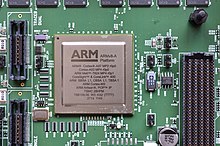AArch64
The main opcode for selecting which group an A64 instruction belongs to is at bits 25–28.
The latter instruction sets provide user-space compatibility with the existing 32-bit ARMv7-A architecture.
[5] Apple was the first to release an ARMv8-A compatible core (Cyclone) in a consumer product (iPhone 5S).
[6] The first ARMv8-A SoC from Samsung is the Exynos 5433 used in the Galaxy Note 4, which features two clusters of four Cortex-A57 and Cortex-A53 cores in a big.LITTLE configuration; but it will run only in AArch32 mode.
It also adds cryptography instructions supporting AES, SHA-1/SHA-256 and finite field arithmetic.
Its enhancements fell into these categories:[30][31][32] On 2 August 2019, Google announced Android would adopt Memory Tagging Extension (MTE).
Its enhancements fell into these categories:[30][42] For example, fine-grained traps, Wait-for-Event (WFE) instructions, EnhancedPAC2 and FPAC.
In October 2024, ARMv9.6-A was announced, including:[51] The ARM-R architecture, specifically the Armv8-R profile, is designed to address the needs of real-time applications, where predictable and deterministic behavior is essential.
This profile focuses on delivering high performance, reliability, and efficiency in embedded systems where real-time constraints are critical.
With the introduction of optional AArch64 support in the Armv8-R profile, the real-time capabilities have been further enhanced.
The Cortex-R82[52] is the first processor to implement this extended support, bringing several new features and improvements to the real-time domain.
